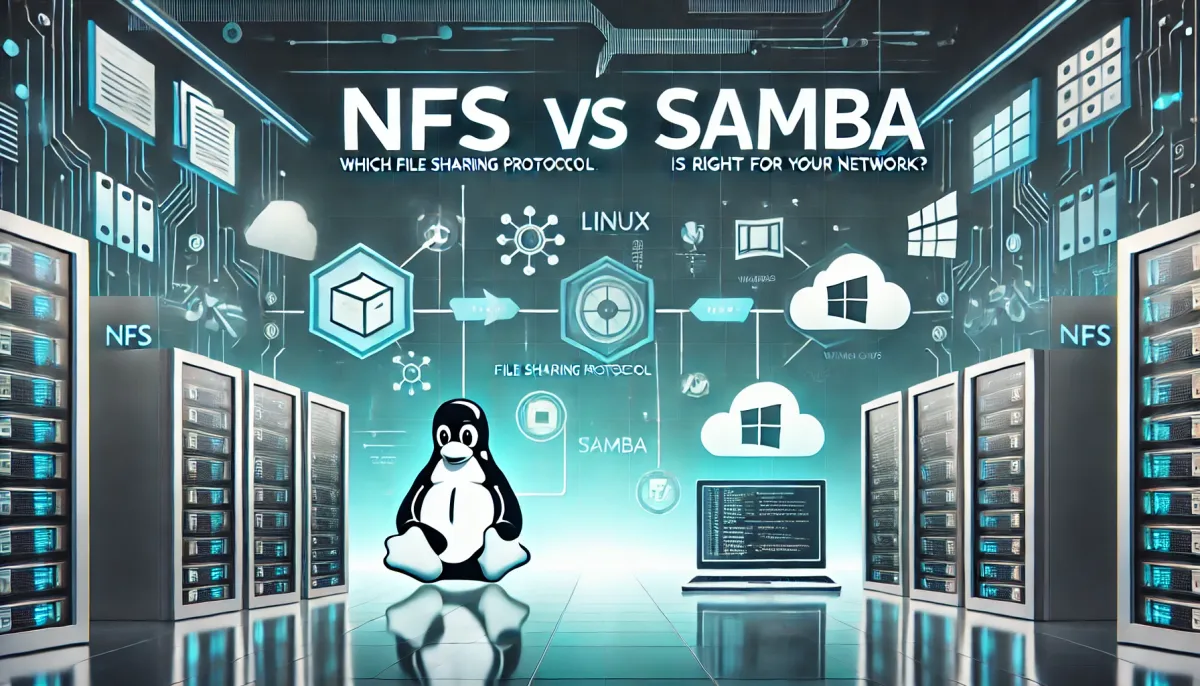NFS vs Samba: Which File Sharing Protocol Is Right for Your Network?

File sharing is crucial to any modern network, whether at home, in the office, or across large IT infrastructures. Choosing a suitable protocol or tool to share files can significantly impact performance, security, and ease of use. Two popular network file-sharing options are NFS (Network File System) and Samba. Let’s break down what they are, how they work, and which one might best fit your needs.
What is Network File System (NFS) and How Does It Work?
NFS is a file-sharing protocol explicitly designed for Unix/Linux systems. Created by Sun Microsystems in 1984, it allows users to access files stored on remote servers as if they were local. It’s widely used in Unix/Linux-based networks and excels in environments with homogeneous systems.
How NFS Works
- A client sends a request to the NFS server for a file or directory.
- The server checks the availability of the resource and the client’s permissions.
- Once authorized, the server shares the file or directory over a virtual connection, making it accessible on the client system as if it were local.
Pros of NFS
- Fast Performance: Ideal for networks with large files or high data throughput needs.
- Cross-Platform Support: Though native to Unix/Linux, NFS can work on other systems with third-party tools.
- Centralized Management: Keeps data on a central server, simplifying management.
- Ease of Setup: Straightforward to configure, especially in Unix/Linux-heavy networks.
Cons of NFS
- Security Challenges: Lacks built-in encryption, requiring additional security measures.
- Network Dependency: Performance can drop in high-latency or unreliable networks.
- Basic Locking Mechanisms: Limited file-locking features can lead to conflicts.
NFS Security
NFS relies on host-based authentication, which can be less secure than modern encryption standards. To secure NFS:
- Use firewalls and VPNs to protect your network.
- Encrypt data using secure protocols.
- Limit access permissions to trusted hosts only.
What is Samba and How Does It Work?
Samba is an open-source software suite that enables Unix/Linux systems to implement the SMB (Server Message Block) protocol. SMB, initially developed by IBM and later enhanced by Microsoft, is the default file-sharing protocol for Windows systems. Samba bridges the gap between Unix/Linux and Windows, making it essential for mixed operating system environments.
SMB is Not Samba
While SMB is the protocol, Samba is the software that implements it on Unix/Linux systems. Samba allows Linux servers to interact seamlessly with Windows machines, enabling resource sharing beyond just files, such as printers and storage devices.
Pros of SMB
- Broad Compatibility: Works across Windows, macOS, Linux, and even Android.
- Advanced Security: Supports encryption, authentication, and message signing.
- Comprehensive Resource Sharing: Goes beyond files to include printers and virtual machines.
- File Locking: Robust locking mechanisms to prevent conflicts.
Cons of SMB
- Complex Setup: Can be tricky to configure, especially for large-scale networks.
- Security Vulnerabilities: Historically targeted by ransomware and worm attacks.
- Performance Issues in WANs: Slower in high-latency networks.
- Licensing Costs: Some implementations require licenses, adding to costs.
Samba Security
Samba enhances SMB’s security features on Unix/Linux systems by offering:
- Encryption for Data Transfer: Protects data during communication.
- Granular Permissions: Provides fine-tuned access control.
- Active Directory Integration: Enables centralized user authentication.
When Should I Use NFS or Samba?
Comparing Performance
- NFS: Known for its fast performance in Unix/Linux networks, especially for read-heavy tasks and large file transfers.
- Samba: Performs better in Windows environments and is optimized for write-heavy operations.
Key Scenarios for Each
- Use NFS:
- When your network is predominantly Unix/Linux.
- For applications requiring high data throughput and low latency.
- In homogeneous environments with fewer security concerns.
- Use Samba:
- In mixed networks requiring Windows and Unix/Linux compatibility.
- For sharing printers and other resources alongside files.
- When strong security and Active Directory integration are critical.
Let's look at a comparison table summarising the key differences and features of Samba and NFS:
| Feature | Samba (SMB Implementation) | NFS (Network File System) |
|---|---|---|
| Primary Use | File and resource sharing between Unix/Linux and Windows systems. | File sharing primarily in Unix/Linux environments. |
| Protocol | Implements the SMB (Server Message Block) protocol. | Uses the NFS (Network File System) protocol. |
| Operating System Compatibility | Cross-platform: Works with Windows, Linux, macOS, and Android. | Primarily Unix/Linux, with some support for macOS and Windows using third-party tools. |
| Resource Sharing | Files, directories, printers, and other networked resources. | Files and directories only. |
| File Locking | Robust file locking to prevent simultaneous edits. | Basic file locking, prone to conflicts. |
| Security | Advanced security features like encryption, Kerberos, and NTLM. | Relies on host-based authentication; additional security measures like VPNs are recommended. |
| Performance | Optimized for Windows and write-heavy tasks. | Performs better in read-heavy tasks and Unix/Linux setups. |
| Configuration | More complex to configure, especially in large networks. | Relatively simple, particularly for Unix/Linux environments. |
| Network Dependency | Slower over high-latency or WAN networks. | Also affected by network latency but performs well in local networks. |
| Active Directory Support | Full integration with Windows Active Directory. | No native Active Directory support. |
| Caching | Server-side caching for better performance. | Client-side caching for faster access. |
| Cost | May involve licensing fees for certain implementations. | Open-source and free in most cases. |
| Best Use Case | Mixed OS environments needing Windows integration and resource sharing. | Homogeneous Unix/Linux environments with high throughput needs. |
The Conclusion.
When choosing between Samba and NFS for your home lab versus a production environment, the decision hinges on your specific needs and setup. For a home lab, NFS might be the ideal choice if you're working primarily with Unix/Linux systems, as it’s easy to set up, lightweight, and delivers high performance for tasks like media streaming or file backups. However, if your lab involves Windows machines or you want to experiment with cross-platform compatibility, Samba offers the versatility to seamlessly bridge Unix/Linux and Windows systems.
In a production environment, the stakes are higher, and the choice depends on the operating systems in your network and the level of security and integration required. For Linux-heavy production networks, NFS shines with its simplicity and performance. Meanwhile, in mixed OS environments where security, Active Directory integration, and resource sharing go beyond files, Samba is a powerful, secure option. Carefully consider your network’s demands, operating system mix, and whether advanced features like encryption or Active Directory integration are essential. Balancing these factors ensures you select the best protocol for reliable, efficient file sharing.
Choosing between NFS and Samba depends on your network’s setup and specific needs. Whether you’re managing a Unix/Linux-based environment or a mixed OS network, understanding the strengths and limitations of these protocols will help you make the right choice. For more IT tips and expert advice, visit JimGogarty.com.
FAQs on NFS vs Samba
FAQs on NFS vs Samba
Q: Is NFS faster than Samba?
A: NFS is often faster in Unix/Linux networks for read-heavy tasks, while Samba is better in write-heavy tasks in Windows networks.
Q: Can I use Samba without SMB?
A: No, Samba is an implementation of the SMB protocol, so they work together.
Q: Does NFS work on Windows?
A: Yes, but it requires third-party tools since NFS isn’t natively supported in Windows.
Q: Which is more secure, NFS or Samba?
A: Samba is generally more secure due to its encryption and advanced authentication options.
FAQs About JimGogarty.com
FAQs About JimGogarty.com
Q: What topics does JimGogarty.com cover?
A: My blog focuses on IT support, cybersecurity, and tech solutions, including file-sharing protocols, backup systems, and network optimization.
Q: Can I request content or consulting services?
A: Absolutely! Visit JimGogarty.com for inquiries or collaborations.
Q: How can I stay updated on your latest posts?
A: Follow my blog and connect with me on LinkedIn for regular updates and insights.




